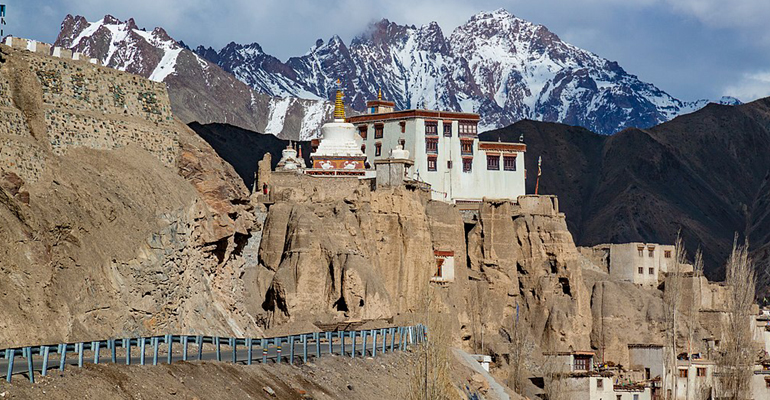Welcome to
LEH
Is the joint capital and largest city of Ladakh, a union territory of India. Leh, located in the Leh district, was also the historical capital of the Kingdom of Ladakh, the seat of which was in the Leh Palace, the former residence of the royal family of Ladakh, built in the same style and about the same time as the Potala Palace in Tibet. Leh is at an altitude of 3,524 m (11,562 ft), and is connected via National Highway 1 to Srinagar in the southwest and to Manali in the south via the Leh-Manali Highway (Part of National Highway 3 connect leh).

History
People of Leh Wearing Traditional Dress.Leh was an important stopover on trade routes along the Indus Valley between Tibet to the east, Kashmir to the west and also between India and China for centuries. The main goods carried were salt, grain, pashm or cashmere wool, charas or cannabis resin from the Tarim Basin, indigo, silk yarn and Banaras brocade. Although there are a few indications that the Chinese knew of a trade route through Ladakh to India as early as the Kushan period (1st to 3rd centuries CE) and certainly by Tang dynasty, little is actually known of the history of the region before the formation of the kingdom towards the end of the 10th century by the Tibetan prince, Skyid lde nyima gon (or Nyima gon), a grandson of the anti-Buddhist Tibetan king, Langdarma (r. c. 838 to 841).
He conquered Western Tibet, although his army originally numbered only 300 men. Several towns and castles are said to have been founded by Nyima gon and he apparently ordered the construction of the main sculptures at Shey.
"In an inscription, he says he had them made for the religious benefit of the Tsanpo (the dynastical name of his father and ancestors), and of all the people of Ngaris (Western Tibet). This shows that already in this generation Langdarma's opposition to Buddhism had disappeared." Shey, just 15 km east of modern Leh, was the ancient seat of the Ladakhi kings.
During the reign of Delegs Namgyal (1660–1685), the Nawab of Kashmir, which was then a province in the Mughal Empire, arranged for the Mongol army to temporarily leave Ladakh, though it returned later. As payment for assisting Delegs Namgyal in the Tibet-Ladakh-Mughal War of 1679–1684, the Nawab made a number of onerous demands.
One of the least was to build a large Sunni Muslim mosque in Leh at the upper end of the bazaar in Leh, below the Leh Palace. The mosque reflects a mixture of Islamic and Tibetan architecture and can accommodate more than 500 people. This was apparently not the first mosque in Leh; there are two smaller ones which are said to be older.
Several trade routes have traditionally converged on Leh, from all four directions. The most direct route was the one the modern highway follows from the Punjab via Mandi, the Kulu valley, over the Rohtang Pass, through Lahaul and on to the Indus Valley, and then downriver to Leh. The route from Srinagar was roughly the same as the road that today crosses the Zoji La (pass) to Kargil, and then up the Indus Valley to Leh.
From Baltistan there were two difficult routes: the main one ran up the Shyok Valley from the Indus, over a pass and then down the Hanu River to the Indus again below Khalsi (Khalatse).
The other ran from Skardu straight up the Indus to Kargil and on to Leh. Then, there were both the summer and winter routes from Leh to Yarkand via the Karakoram Pass and Xaidulla. Finally, there were a couple of possible routes from Leh to Lhasa.
The first recorded royal residence in Ladakh, built at the top of the high Namgyal ('Victory') Peak overlooking the present palace and town, is the now-ruined fort and the gon-khang (Temple of the Guardian Divinities) built by King Tashi Namgyal.
Tashi Namgyal is known to have ruled during the final quarter of the 16th century CE.
The Namgyal (also called "Tsemo Gompa 'Red Gompa', or d Gon-pa-so-ma='New Monastery'), a temple, is the main Buddhist centre in Leh. There are some older walls of fortifications behind it which Francke reported used to be known as the "Dard Castle."
If it was indeed built by Dards, it must pre-date the establishment of Tibetan rulers in Ladakh over a thousand years ago.
The Sankar Labrang (Bsam dkar bla brang) is a small, two-storeyed building owned by Sankar monastery. Sankar monastery is the seat of Bakula Rinpoche, immediately to the northwest of Leh.
The monastery's Labrang building is located in the old town of Leh, in the Manikhang neighbourhood. Manikhang is the area between the main bazaar of Leh and the historic Stalam path that leads up to the royal palace.
Four huge stūpas standing at this point mark the beginning of historic Leh. In recent memory, the Sankar Labrang had a metalsmith's workshop downstairs, while upstairs lived the monk caretaker of the White Maitreya Temple (Byams khang dkar po), also known locally as "Street Maitreya".
The White Maitreya Temple dates back to the reign of King Drakpa Bumd´e (Grags pa 'bum lde, r. ca 1410–1435), following the arrival of a mission sent to Ladakh by the Tibetan lama Tsongkhapa.
Below this are the Chamba (Byams-pa, i.e., Maitreya) and Chenresi (sPyan-ras-gzigs, i.e. Avalokiteshvara) monasteries which are of uncertain date.
Leh Palace
Old palace of the kings in LehThe royal palace, known as Leh Palace, was built by King Sengge Namgyal (1612–1642), presumably between the period when the Portuguese Jesuit priest, Francisco de Azevedo, visited Leh in 1631, and made no mention of it, and Sengge Namgyal's death in 1642.
The Leh Palace is nine storeys high; the upper floors accommodated the royal family, and the stables and storerooms are located on the lower floors.The palace was abandoned when Kashmiri forces besieged it in the mid-19th century. The royal family moved their premises south to their current home in Stok Palace on the southern bank of the Indus River. As has already been mentioned, the original name of the town is not sLel, as it is nowadays spelled, but sLes, which signifies an encampment of nomads. These [Tibetan] nomads were probably in the habit of visiting the Leh valley at a time when it had begun to be irrigated by Dard colonisers. Thus, the most ancient part of the ruins on the top of rNam-rgyal-rtse-mo hill at Leh are called 'aBrog-pal-mkhar (Dard castle) . In 2010, Leh was heavily damaged by the sudden floods caused by a cloud burst.
Administration
Unlike other districts in India, the Ladakh Autonomous Hill Development Council (LAHDC) is in charge of governance in Leh. It has 30 councillors, 4 nominated and 26 elected. The Chief Executive Councillor heads and chairs this council. The Deputy Commissioner of Leh also holds the power of Chief Executive Officer of the LAHDC. The current Deputy Commissioner of Leh district is Sachin Kumar Vaishya.Geography
Leh and its surroundingsThe city is located on the bank of the Indus. The mountains dominate the landscape around the Leh as it is at an altitude of 3,500m. Peaks, such as Nanga Sago, can reach well above 5,500m. The principal access roads include the 434 km Srinagar-Leh highway which connects Leh with Srinagar and the 428 km Leh-Manali Highway which connects Manali with Leh. Both roads are open only on a seasonal basis.[20] Although the access roads from Srinagar and Manali are often blocked by snow in winter, the local roads in the Indus Valley usually remain open due to the low level of precipitation and snowfall.
Climate
Leh has a cold desert climate (Köppen climate classification BWk) with long, cold winters from late November to early March, with minimum temperatures well below freezing for most of the winter. The city gets occasional snowfall during winter, which is very cold by Indian standards, mainly due to its high elevation.The weather in the remaining months is generally fine and warm during the day. Average annual rainfall is only 102mm (4.02 inches). In 2010, the city experienced flash floods that killed more than 100 people. Steep mountains rise to very high altitudes on either side of the Spiti River and its numerous tributaries. The highest peak in the Parung range to the NE has an altitude of 7,030 m (23,064 ft) and on the SW side, is Manirang Peak at 6,598 m (21,646 ft). The mountains are barren and largely devoid of trees except for a few stunted willows and scattered trees in a some villages. The main settlements along the Spiti River and its tributaries are Kaza and Tabo.
Agriculture
A view of agriculture around Leh.Leh is located at an average elevation of about 3500 metres, which means that only one crop a year can be grown there, while two can be grown at Khalatse. By the time crops are being sown at Leh in late May, they are already half-grown at Khalatse.
The main crop is grim (naked barley – Hordeum vulgare L. var. nudum Hook. f., which is an ancient form of domesticated barley with an easier to remove hull) – from which tsampa, the staple food in Ladakh, is made.
The water for agriculture of Ladakh comes from the Indus, which runs low in March and April when barley-fields have the greatest need for irrigation. Grapes, apricots, currants, walnuts, and apples are nonetheless also grown in its arid temperate climate.
People of Leh
As of 2011 India census, Leh town had a population of 30,870. Males constitute 70% of the population and females 30%, due to a large presence of non-local labourers, traders and government employees. Child sex ratio is 987. Leh has an average literacy rate of 90%, more than the national average of 74.04%: male literacy is 94.89%, and female literacy is 78.85%. In Leh, 5.5% of the population is under 6 years of age. The people of Leh are ethnic Tibetan, speaking Ladakhi, a Tibetic language. The Muslim presence dates back to the annexation of Ladakh by Kashmir, after the Fifth Dalai Lama came to Ladakh from Tibet. Since then, there has been further migration from the Kashmir Valley due firstly to trade and latterly with the transfer of tourism from the Kashmir Valley to Ladakh.Ladakh receives very large numbers of tourists for its size. In 2010, 77,800 tourists arrived in Leh. Numbers of visitors have swelled rapidly in recent years, increasing 77% in the 5 years to 2010. This growth is largely accounted for by larger numbers of trips by domestic Indian travellers.


